

Zitierweise / cite as:
Payer, Alois <1944 - >: Chronik Thailands = กาลานุกรมสยามประเทศไทย. -- Chronik 1824-07 bis 1824-12 (Rama III). -- Fassung vom 2017-01-25. -- URL: http://www.payer.de/thailandchronik/chronik1824-2.htm
Erstmals publiziert: 2013-07-01
Überarbeitungen: 2017-01-25 [Ergänzungen] ; 2016-04-12 [Ergänzungen] ; 2015-10-12 [Ergänzungen] ; 2015-07-03 [Ergänzungen] ; 2015-05-09 [Teilung des Kapitels] ; 2015-05-08 [Ergänzungen] ; 2015-04-22 [Ergänzungen] ; 2015-03-16 [Ergänzungen] ; 2015-03-04 [Ergänzungen] ; 2015-01-24 [Ergänzungen] ; 2014-12-15 [Ergänzungen] ; 2014-11-13 [Ergänzungen] ; 2014-11-04 [Ergänzungen] ; 2014-10-27 [Ergänzungen] ; 2014-09-21 [Ergänzungen] ; 2014-08-20 [Ergänzungen] ; 2014-03-26 [Ergänzungen] ; 2014-03-08 [Ergänzungen] ; 2014-02-26 [Ergänzungen] ; 2014-01-13 [Ergänzungen] ; 2013-12-20 [Ergänzungen] ; 2013-12-05 [Ergänzungen] ; 2013-11-25 [Ergänzungen] ; 2013-11-05 [Ergänzungen] ; 2013-10-11 [Ergänzungen] ; 2013-09-28 [Ergänzungen] ; 2013-09-23 [Ergänzungen] ; 2013-09-17 [Ergänzungen] ; 2013-09-02 [Ergänzungen] ; 2013-08-23 [Ergänzungen] ; 2013-08-21 [Ergänzungen] ; 2013-08-14 [Ergänzungen] ; 2013-08-11 [Ergänzungen] ; 2013-07-13 [Ergänzungen] ; 2013-07-10 [Ergänzungen] ; 2013-07-08 [Ergänzungen]
©opyright: Dieser Text steht der
Allgemeinheit zur Verfügung. Eine Verwertung in Publikationen, die über übliche
Zitate hinausgeht, bedarf der ausdrücklichen Genehmigung des Herausgebers.
Dieser Text ist Teil der Abteilung
Thailand von
Tüpfli's Global Village Library
ช้างตายทั้งตัวเอาใบบัวปิดไม่มิด
|
Gewidmet meiner lieben Frau Margarete Payer die seit unserem ersten Besuch in Thailand 1974 mit mir die Liebe zu den und die Sorge um die Bewohner Thailands teilt. |
|
Bei thailändischen Statistiken muss man mit allen Fehlerquellen rechnen, die in folgendem Werk beschrieben sind:
Die Statistikdiagramme geben also meistens eher qualitative als korrekte quantitative Beziehungen wieder.
|
Kinderwiegen:
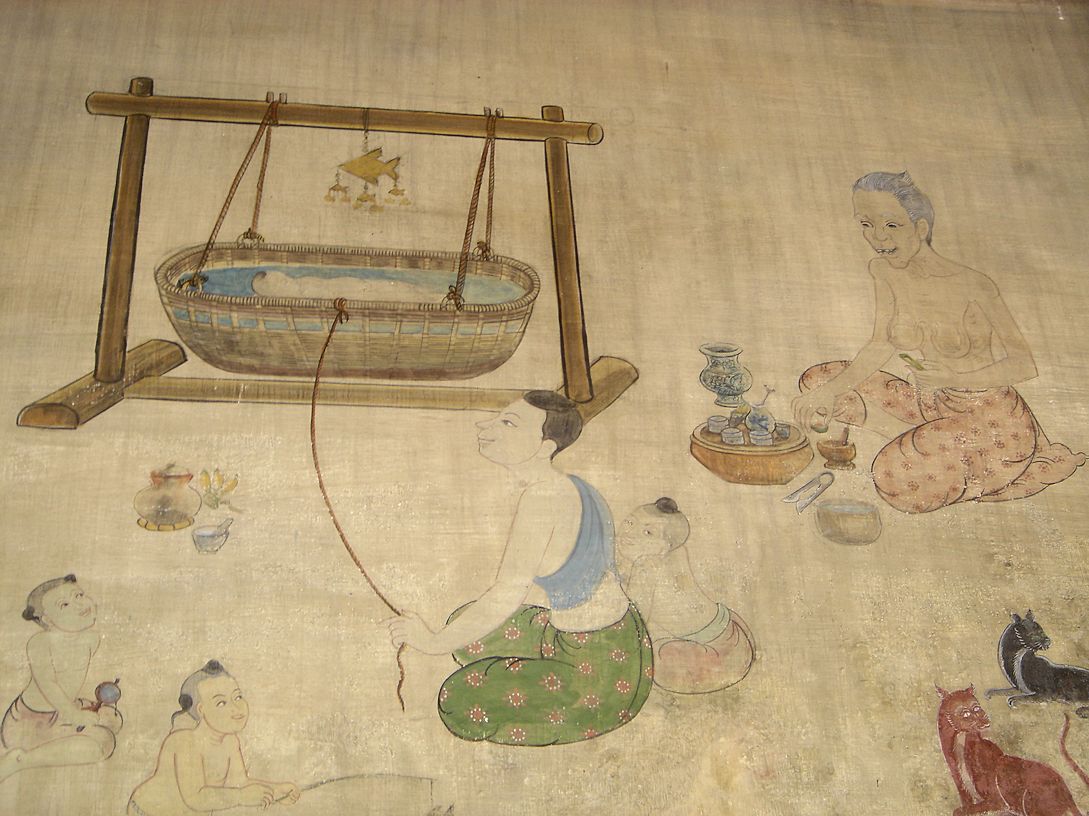
Abb.: Kinderwiegen, Wandmalerei, Wat Pho (วัดโพธิ์),
Bangkok
[Bildquelle: MsAnthea. --
http://www.flickr.com/photos/anthea/9141029/. -- Zugriff am 2012-03-14. --
Creative Commons Lizenz (Namensnennung, keine Bearbeitung)]
Traditionelle Spiele:
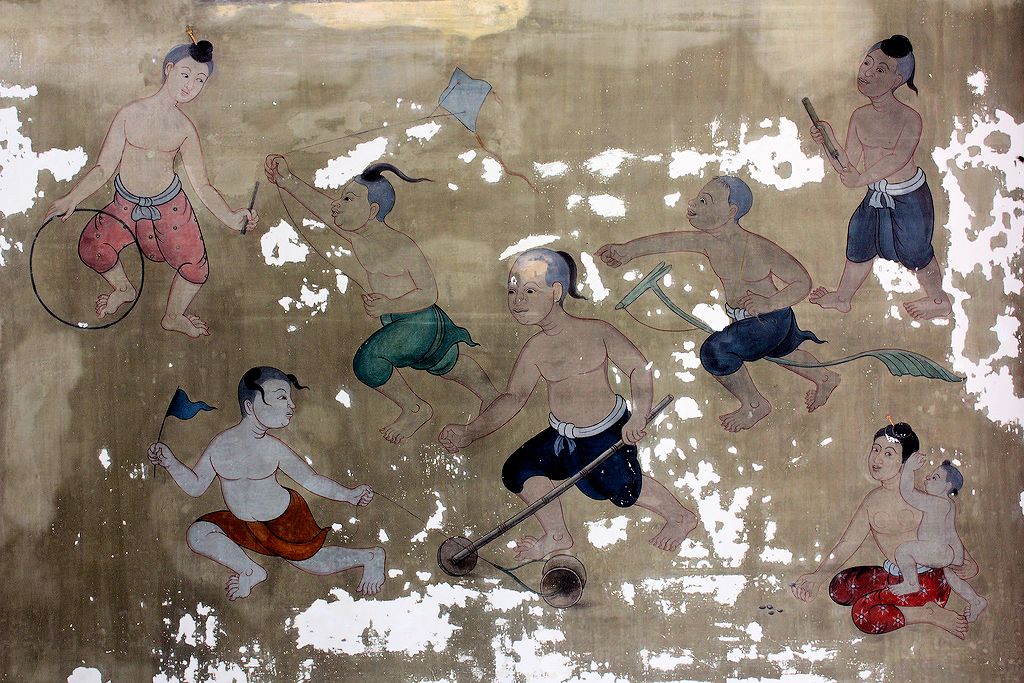
Abb.: Traditionelle Spiele, Wandmalerei, Wat Pho (วัดโพธิ์),
Bangkok
[Bildquelle: Magalie L'Abbé. --
http://www.flickr.com/photos/magtravels/5430532503/. -- Zugriff am
2012-03-14. --
Creative Commons Lizenz (Namensnennung, keine kommerzielle Nutzung)]
Häusliche Szene:
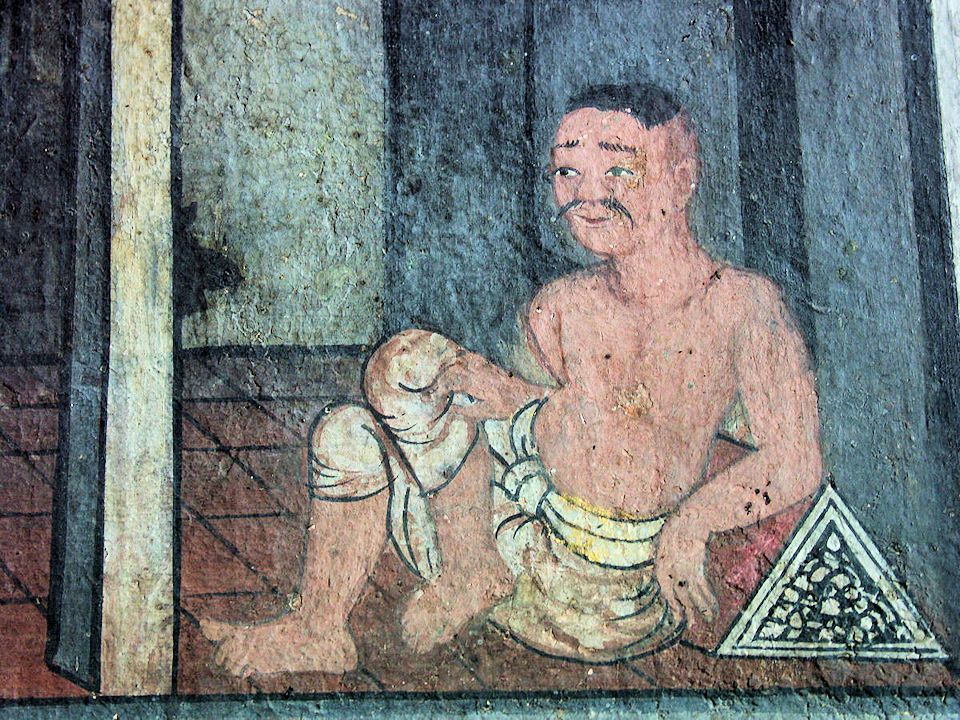
Abb.: Häusliche Szene. Wandmalerei, Wat Suthat (วัดสุทัศนเทพวราราม),
Bangkok
[Bildquelle: Mattana / Wikimedia. -- Public domain]
Verkäuferin in Boot:
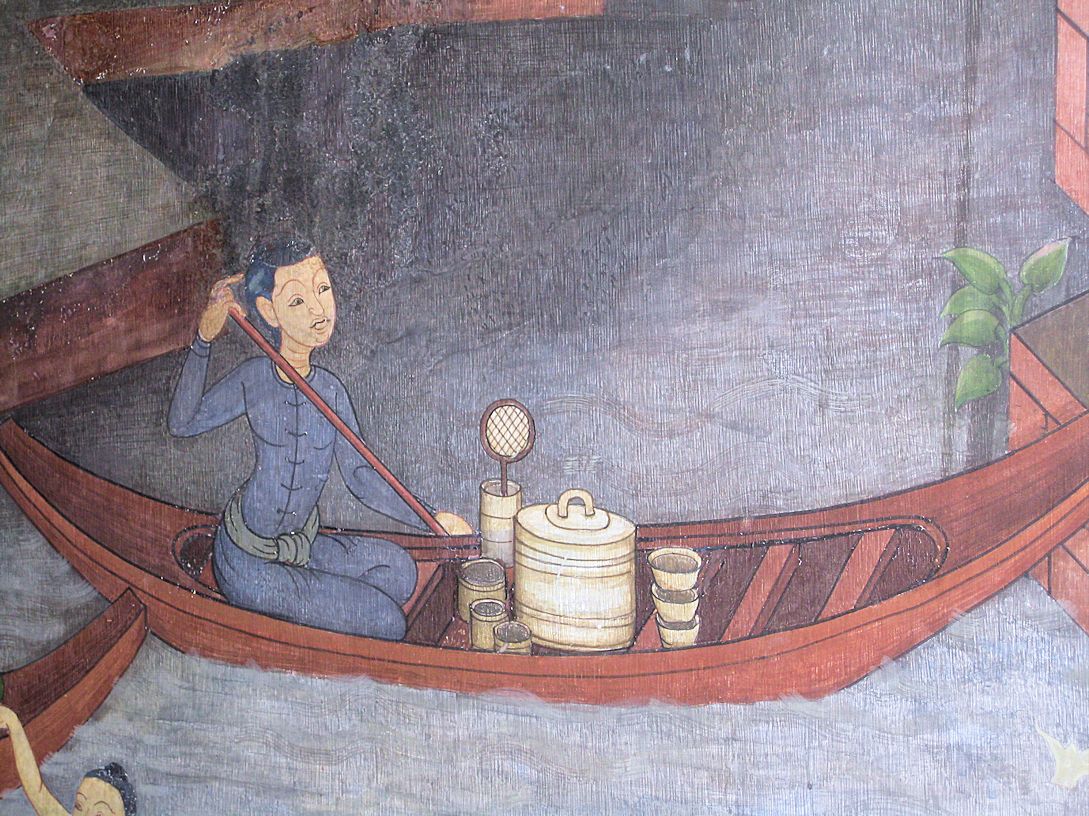
Abb.: Verkäuferin in Boot, Wandmalerei, Wat Pho (วัดโพธิ์),
Bangkok
[Bildquelle: hewy. --
http://www.flickr.com/photos/hewy/3252541901/. -- Zugriff am 2012-03-14. --
Creative Commons
Lizenz (Namensnennung, keine kommerzielle Nutzung, keine Bearbeitung)]
Statistik:
|
1824-07-21 - 1851-04-02

Rama III.: Phra Bat Somdet Phra Poramintharamaha Jessadabodindra Phra Nangklao Chao Yu Hua - พระบาทสมเด็จพระปรมินทรมหาเจษฏาบดินทร์ฯ พระนั่งเกล้าเจ้าอยู่หัว
Rama III. erhält vom chinesischen Kaiser den Namen 鄭福 (Tae Hok)
Rama III. führt während seiner Herrschaft 38 neue Steuern ein, um den Luxus des Herrscherhauses finanzieren zu können.
Statistik:
- 22 Söhne
- 29 Töchter
- die 51 Kinder stammen von 35 Frauen
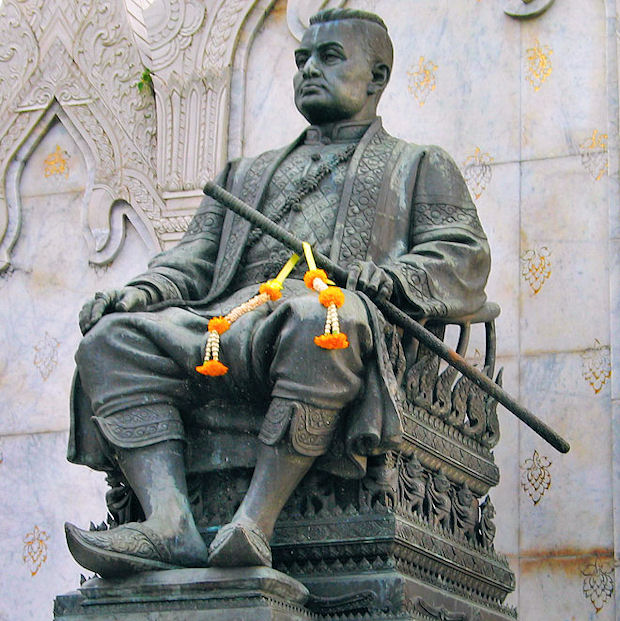
Abb.: Rama III. -- nahe von Wat Ratchanaddaram -
วัดราชนัดดาราม, Bangkok - กรุงเทพฯ
[Bildquelle: Heinrich Damm / Wikimedia. -- GNU FDLicense]
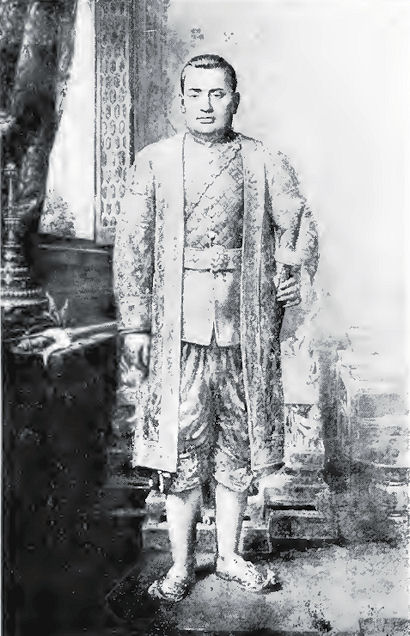
Abb.: Rama III.
"Maha Chestabodin (Thai: พระบาทสมเด็จพระปรมินทร มหาเจษฏาบดินทร์ฯ พระนั่งเกล้าเจ้าอยู่หัว; später: Phra Nang Klao, nachträglich von König Mongkut verliehen), im Westen besser bekannt als Rama III. (* 31. März 1788; † 2. April 1851 in Bangkok, Thailand) war von 1824 bis 1851 König von Siam. Bangkok bestand bereits mehr als vierzig Jahre, als sich Phra Nang Klao durch den Kronrat ernennen ließ. Viele Gebäude bedurften einer Renovierung und Festigung. Schon sein Vater nannte ihn Chao Sua (เจ้าเสือ) (so viel wie Handelsvorstand), da er bereits als Prinz eine glückliche Hand bei Geschäften mit dem Ausland beweisen konnte. Ein überlieferter Trick: er sorgte für den Export wertvoller Waren und für die Einfuhr von Waren mit hohem Gewicht, was dazu führte, dass stets Schiffe mit ausreichend hoher Tonnage in Bangkok vor Anker lagen. So durfte er schon als Prinz den Hafen von Bangkok leiten und war damit zuständig für den Außenhandel und die Handelsbeziehungen.
Um die Wirtschaft weiter anzukurbeln, ließ er Wasserstraßen (auch die Khlongs in Bangkok) ausheben, welche die großen Flüsse des Landes miteinander verbinden sollten. Noch heute sind die großen Wasserstraßen in Betrieb.
Die jahrhundertelangen Kämpfe mit Birma, Kambodscha und Vietnam gehörten größtenteils der Vergangenheit an. Konflikte gab es mit dem laotischen Königreich Vientiane, dessen König Anouvong einen Aufstand im siamesischen Isaan anstiftete und 1828 von General Bodindecha nach Bangkok gebracht wurde. Dort wurde Anouvong auf Befehl des Königs öffentlich ausgestellt und schließlich zu Tode gemartert. 1838 bis 1839 standen die Malaien in Kedah gegen Siam auf und wurden mühsam niedergeworfen. Zwischen 1841 und 1845 führte Siam den Siamesisch-Vietnamesischen Krieg um Kambodscha. Dabei konnte sich General Bodindecha erneut auszeichnen. Nach dem Friedensschluss wurde der Siam wohlgesinnte König Ang Duong auf den Thron Kambodschas gesetzt.
Die Außenpolitik König Ramas III. war jedoch von großer Vorsicht gegenüber den Europäern gekennzeichnet, schließlich begannen die ersten Kolonisierungsversuche in Südostasien. Er wollte gerne von ihnen lernen, was nützlich war, ohne aber ihren Lebensstil zu übernehmen.
Seinem Nachfolger Mongkut (Rama IV.), den er selbst nach dessen Fähigkeiten ausgesucht hatte, hinterließ er ein wirtschaftlich gesundes Land, das eine neue Blütezeit der Kultur erlebte und die erfolgreiche Schaukelpolitik den Europäern gegenüber weitergeführt hatte."
[Quelle: http://de.wikipedia.org/wiki/Rama_III.. -- Zugriff am 2011-10-06]
Namen und Titel:
- 1788-1808: His Serene Highness Prince Thap (หม่อมเจ้าชายทับ)
- 1808-1813: His Highness Prince Thap (พระเจ้าลูกยาเธอ พระองค์เจ้าชายทับ)
- 1813-1824: His Royal Highness Prince Thap, the Prince Chetsadabodin (สมเด็จพระเจ้าลูกเธอ กรมหมื่นเจษฎาบดินทร์)
- 1824-1851: His Majesty King Borommarachathirat Ramathibodi (พระบาทสมเด็จพระบรมราชาธิราชรามาธิบดี ศรีสินทรบรมมหาจักรพรรดิราชาธิบดินทร์ ธรณินทราธิราช รัตนากาศภาสกรวงศ์ องค์ปรมาธิเบศร์ ตรีภูวเนตรวรนายก ดิลกรัตนราชชาติอาชาวไสย สมุทัยดโรมน สากลจักรวาลาธิเบนทร์ สุริเยนทราธิบดินทร์ หริหรินทราธาธิบดี ศรีสุวิบูลย คุณอถพิษฐ ฤทธิราเมศวร ธรรมิกราชาธิราช เดโชชัย พรหมเทพาดิเทพนฤบดินทร์ ภูมินทรปรมาธิเบศร โลกเชษฐวิสุทธิ มงกุฏประเทศคตา มหาพุทธางกูร บรมบพิตร พระพุทธเจ้าอยู่หัว)
- Posthumously renamed by King Mongkut : King Nangklao (พระบาทสมเด็จพระนั่งเกล้าเจ้าอยู่หัว พระมหาเจษฎาราชเจ้า)
[Quelle: th.Wikipedia und en.Wikipedia]

Rama III. ernannte keine seiner zahlreichen Frauen zur Königin.

Am Hofe Ramas III beginnt man Karten zu spielen. Vom Hof aus verbreitet sich Kartenspielen sehr schnell, Unter Rama IV. und Rama V. wurden Kartenspiele der neuesten Mode sehr beliebt.
Abb.: Einbandtitel: ไพ่ป๊อก (Kartenspiel), o. J.
Zur Zeit von Rama III. besteht das Mahori-Orchester (วงมโหรี) aus zwölf Musikern. Neu hinzugekommen sind:
Ranat thum (ระนาดทุ้ม)
Khong wong lek (ฆ้องวงเล๊ก)
Ching (ฉิ่ง)
Chap (ฉับ) (gedämpfte Ching)
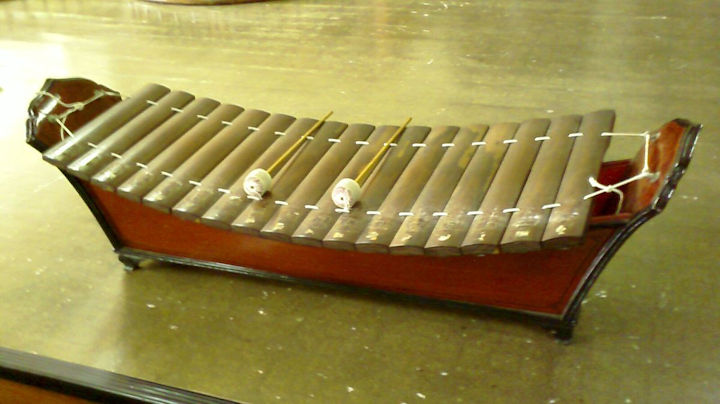
Abb.: Ranat thum (ระนาดทุ้ม),
2009
[Bildquelle: Paul_012 / Wikimedia. -- GNU FDLicense]
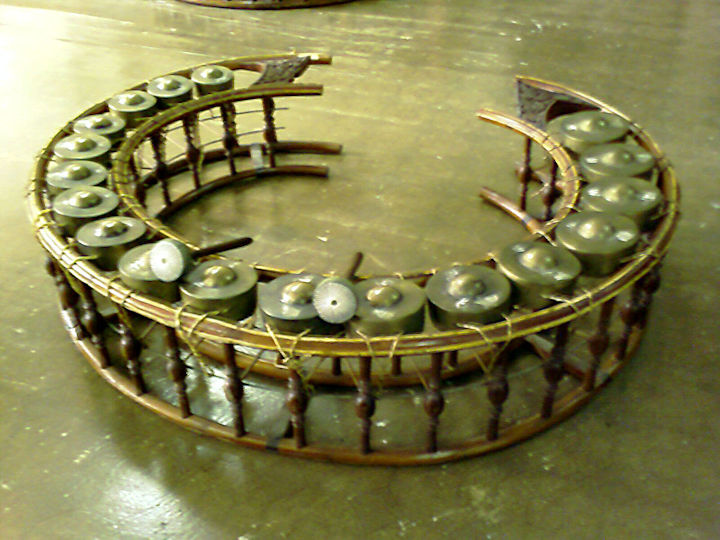
Abb.: Khong wong lek (ฆ้องวงเล๊ก), 2009
[Bildquelle: Paul_012 / Wikimedia. -- GNU FDLicense]
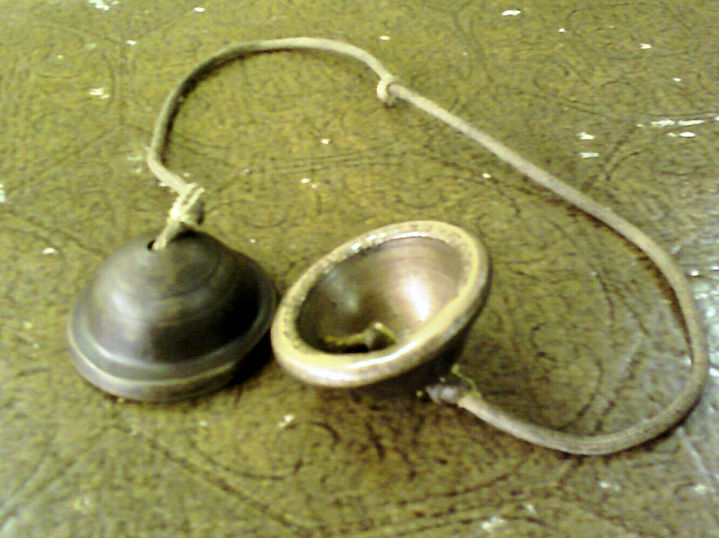
Abb.: Ching (ฉิ่ง), 2009
[Bildquelle: Paul_012 / Wikimedia. -- GNU FDLicense]
1824

Manthaturath (เจ้ามันธาตุราช), König von Luang Prabang (ພຣະຣາຊອານາຈັກຫລວງພະບາງ) kommt nach Bangkok zur Kremation von Rama II., wird Mönch auf Zeit, bleibt anschließend so lange in Bangkok bis ihn Rama III. wieder zurückschickt, lässt seinen Sohn in Bangkok zur Ausbildung bei den königlichen Pagen.
1824
Die Hofastrologen Ramas III. notieren eine Anzahl schlechter Vorzeichen:
""Thursday, the second day of the waning moon of the fifth month, at three hours pm, cyclone on earth and on sea. The spire of the royal palace dropped in the palace . . . Friday, the seventh day of the waning moon of the seventh month, the white elephant offered by Nan [น่าน] is dead.
Sunday, the ninth day of the waxing moon of the seventh month, the white elephant offered by Chiang Mai [เชียงใหม่] is dead."
[Zitiert in: Mayoury Ngaosyvathn [ມະຍຸຣີ ເຫງົ້າສຼີວັດທະນາ] ; Pheuiphanh Ngaosyvathn [ເຜີຍພັນ ເຫງົ້າສຼີວັດທະນາ] <1946 - >: Paths to conflagration : fifty years of diplomacy and warfare in Laos, Thailand, and Vietnam, 1778-1828. -- Ithaca, N.Y. : Cornell Univ., 1998. -- 270 S. ; 26 cm. -- (Studies on Southeast Asia ; 24). -- ISBN 0-87727-723-0. -- S. 75, Anm. 62]
1824
Abb.: Plan von Bangkok, 1824
[Bildquelle: Twentieth century impressions of Siam : its history, people, commerce, industries, and resources / ed. in chief: Arnold Wright. -- London [etc.] : Lloyds, 1908. -- S. 57]
Abb.: Bangkok 1824
[Bildquelle: Twentieth century impressions of Siam : its history, people, commerce, industries, and resources / ed. in chief: Arnold Wright. -- London [etc.] : Lloyds, 1908. -- S. 51]
Abb.: Palast mit den Urnen verstorbener Könige, Bangkok, 1824
[Bildquelle: Twentieth century impressions of Siam : its history, people, commerce, industries, and resources / ed. in chief: Arnold Wright. -- London [etc.] : Lloyds, 1908. -- S. 58]
Abb.: Der alte Palast, Bangkok, 1824
[Bildquelle: Twentieth century impressions of Siam : its history, people, commerce, industries, and resources / ed. in chief: Arnold Wright. -- London [etc.] : Lloyds, 1908. -- S. 54]
1824
Verstärkung der Verteidigung von Samut Prakan (สมุทรปราการ).
Abb.: Lage von Samut Prakan (สมุทรปราการ)
[Bildquelle: OpenStreetMap. -- Creative Commons Lizenz (Namensnennung, share alike)]
1824
Erlass, dass alle Laoten als Siam Steuer-, Fron- und Militärdienstpflichtige tätowiert werden müssen. Laoten leisten Widerstand.
1824/25
Aufhebung der Befreiung von der Grundsteuer für Staatsbedienstete.
1824
Festsetzung einer neuen Reislandsteuer. Statt einer Naturalabgabe von ca. 40 Liter Reis pro Rai 81600 m² sind jetzt pro Rai 3/8 Baht in Geld zu bezahlen.
1824/1825
Einführung der Salzsteuer.
1824
Rama III. entlässt den Gouverneur von Chanthaburi (จันทบุรี) und ersetzt ihn durch einen Bunnag (บุนนาค)
Abb.: Lage von Chanthaburi (จันทบุรี)
[Bildquelle: OpenStreetMap. -- Creative Commons Lizenz (Namensnennung, share alike)]
1824
Revolte der chinesischen Triade (三合會) in Bang Kacha (บางกะจะ).
Abb.: Lage von Bang Kacha (บางกะจะ)
[Bildquelle: OpenStreetMap. -- Creative Commons Lizenz (Namensnennung, share alike)]
1824
Vernichtung einer chinesischen Geheimgesellschaft, gegen die kein Vorwurf bekannt ist.
1824
Brief eines Bangkoker Portugiesen an John Crawfurd (1783-1868) in Singapur:
"As soon as Prince Kroma Chiat [กรมหมื่นเจษฎาบดินทร์] [Rama III] ascended the throne, he gave orders to allow all nations that visited Siam to buy and sell, export and import, with any inhabitant they thought proper, without hindrance, they paying only the duties. This was done without any altercation with the Chiefs." [Zitiert in: Nidhi Eoseewong [นิธิ เอียวศรีวงศ์] <1940 - >: Pen and sail : literature and history in early Bangkok including the history of Bangkok in the chronicles of Ayutthaya. -- Chiang Mai : Silkworm, 2005. -- 396 S. : Ill. ; 23 cm. -- ISBN 974957592X. -- Originaltitel: ปากไก่และใบเรือ : รวมความเรียงว่าด้วยวรรณกรรม และประวัติศาสตร์ต้นรัตนโกสินทร์ (1984). -- S. 70.]
1824

Captain James Low (gest. 1852) von der British East India Company in Penang wird zum siamesischen Vizekönig von Ligor [ลิกอร์ = Nakhon Si Thammarat - ครศรีธรรม ราช] geschickt, um wegen des britisch-burmanischen Kriegs vorzufühlen, erhält aber keine Audienz. Law besucht unterwegs Phuket (ภูเก็ต) und Phang Nga (พังงา).
Abb.: Lage von Phang Nga (พังงา) und Penang
[Bildquelle: OpenStreetMap. -- Creative Commons Lizenz (Namensnennung, share alike)]
"Before he left Penang, Low had been informed that after the expected EIC [East India Company] victory in their current war with Burma, the EIC harbored a plan to take the province of Tenasserim [ဏၚ်ကသဳ] from Burma and give it back to Siam in exchange for Phuket and all the other offshore islands between Penang and Phuket. The EIC felt that "The Siamese covet this possession [Tenasserim] exceedingly and it may not be improbably conjectured that they would readily accept it in exchange for Junkceylon [Phuket], Pulo Panjang (Ko Yao Yai) [เกาะยาวใหญ่], and Pulo Tellibong ... Of all the Siamese possessions on the west coast, Salang seems to be of the greatest intrinsic value, but to its present possessors it is little better than a barren waste."
This, Low felt, was because of a shortage of people "due to fear" and also due to the "selfish" policies of the king of Siam which
"have a direct tendency to retard the growth ... The Siamese are anxious to encourage population ... but the emperor of Siam follows no law but that of his corrupt will ... he views his subjects in the light of mere instruments by which his pursuits may be forwarded. No rank is hereditary, no property, however arduously acquired, is safe [the sakdi na {ศักดินา} system]. People are torn from the bosom of their families without regard to ability or future consequences and sent on distant expeditions leaving their wives and children to support themselves ... to fill up the vacuity which such a perverted policy creates, they carry off the population of whole villages from the territory of their neighbours and planting them like exotics in a new soil vainly fancy that they will add strength to the state. The Siamese have lately been successful in this species of man-stealing and have carried many thousands of Burman families into captivity.""
[Quelle: Mackay, Colin <1936 - >: A history of Phuket and the surrounding region. -- Bangkok : White Lotus, 2013. -- 438 S. : Ill. ; 25 cm. -- ISBN 978-974-480-195-1. -- S. 260]
"The powers productive of natural wealth now lie dormant under its selfish and avaricious system ... an establishment on Salang [Phuket] by the British would no doubt bring signal aid to the cause of humanity and civilisation by rescuing thousands from their unmerited thraldom, both of mind and body, under which they groan, and of diffusing happiness, the chief end of all good government. The present inhabitants of Salang would rejoice at the change ... preferring positive happiness and a rational degree of freedom to slavery and its attendant degradations and miseries under them [the Siamese]." [Zitiert in: Mackay, Colin <1936 - >: A history of Phuket and the surrounding region. -- Bangkok : White Lotus, 2013. -- 438 S. : Ill. ; 25 cm. -- ISBN 978-974-480-195-1. -- S. 260f.]
Low über Phuket (ภูเก็ต), dessen Bevölkerung er unter 6000 Personen schätzt:
"The Burmans ... keep the people in perpetual commotion and strike terror into the population from Tannau [Tenasserim] [ဏၚ်ကသဳ or တနၚ်သြဳ / ตะนาวศรี] down to Perlis [ﭬﺮليس] ... Captain Forrest in 1784 had rated the population of Salang (Phuket) at 12,000 souls ... but since his day things have changed much for the worse ... I was informed by the chief of Tharooa [ท่าเรือ] ... that the island would not afford more than 1,000 men fit for labour." [Zitiert in: Mackay, Colin <1936 - >: A history of Phuket and the surrounding region. -- Bangkok : White Lotus, 2013. -- 438 S. : Ill. ; 25 cm. -- ISBN 978-974-480-195-1. -- S. 248]
"The Chinese ... are exempted from the duty imposed on every Siamese of serving the state when called on, either in the capacity of soldiers, artisans or day labourers. They are left at more liberty to enjoy what their industry produces. The reason is obvious. The Chinese are a more intelligent, ingenious and laborious race than the Siamese, to whom they have the art to render themselves absolutely necessary, ... We may likewise suppose that the Siamese would not like to irritate a class of men who are so numerous in all their towns." "Unwilling as they [die Chinesen] may be to turn rulers, where nothing could be obtained, or be put in competition with their mercantile gains, they do not seem to be at all averse to intrigue with one, or even with both sides, so that whatever the result, their interests may continue unaffected ... The real leaning in such a case will be to the stronger party, although the weaker will be cajoled by promises and aided by supplies of arms, the sale of which, at high profits, they can easily effect."
[Zitiert in: Mackay, Colin <1936 - >: A history of Phuket and the surrounding region. -- Bangkok : White Lotus, 2013. -- 438 S. : Ill. ; 25 cm. -- ISBN 978-974-480-195-1. -- S. 303]
Abb.: Lage von Tenasserim [ဏၚ်ကသဳ or တနၚ်သြဳ / ตะนาวศรี] und Perlis [ﭬﺮليس]Low über Phang Nga (พังงา):
"The town does not contain more than 70 houses. About 30 of that number belong to Chinese settlers. Their houses are large and convenient and regularly built so as to form a street." Low estimated there were
"6
or 7,000 souls. There were about 600 active Chinese ... The females at Phoonga [Phang Nga] secluded themselves more than those at Salang [Phuket] did, which I attributed to their own modesty ... women in this country are allowed much freedom ... The house of the chief is a little larger than the rest but has scarcely any exterior decoration and is enclosed by palisades of planks and stakes. On the south of the chief’s residence is the Chinese tin smelting house where one furnace is employed. A great portion of the population is employed during half the year at the tin mines, returning during the other months to cultivate rice ... The ore which they dig is sold to the Chinese contractor and the profit goes to the chief... Although the Chief of Phoonga takes advantage of the power given him and enriches himself at the expense of his subjects, his government is not so oppressive as that of the rajah of Ligore [ลิกอร์ = Nakhon Si Thammarat - ครศรีธรรมราช]. His people also are more attached to him, or in other words, do not hate him so violently as the Ligorians hate their prince. The difference showed itself in one instance. In the rajah’s country (Nakorn) every article supplied for my table was extorted from his subjects, but at Phoonga the chief bought out of the bazaar all the provisions he sent to me."[Zitiert in: Mackay, Colin <1936 - >: A history of Phuket and the surrounding region. -- Bangkok : White Lotus, 2013. -- 438 S. : Ill. ; 25 cm. -- ISBN 978-974-480-195-1. -- S. 262]
Low berichtet von chinesischen Piraten aus Macao [澳門], die vermutlich im Auftrag des Gouverneurs von Phang Nga tätig sind:
"In the course of one evening one of my sepoys [सिपाही] [an Indian soldier] happened to be conversing with a native of Hindustan [हिन्दुस्तान / ہندوستان] who ... had been here [Phang Nga] for a year or two. Some Siamese officers came up, seized the Hindustany and having beaten him, conveyed him to prison, observing that he was betraying the secrets of the place. This man had informed my sepoy that a piracy had been committed at the place where our brig then lay (the Phang Nga River) about twelve days previous to our arrival, by twelve Chinamen and five Malays. They had attacked a Coromandel [சோழ மண்டலம்] Chulia [சோழர்] [Tamil Indian] vessel and murdered all her crew and passengers amounting to sixty people and had afterwards plundered and burned her. He added that most of these Chinese were then still in Phang Nga ... My endeavours to ascertain what credit ought to be attached to this account proved fruitless." [Zitiert in: Mackay, Colin <1936 - >: A history of Phuket and the surrounding region. -- Bangkok : White Lotus, 2013. -- 438 S. : Ill. ; 25 cm. -- ISBN 978-974-480-195-1. -- S. 189f.]
Low über die Küste südlich von Phuket:
[The coast south of Phuket is mainly inhabited by Malays who] "detest the Siamese and never fail when they can do so with chance of impunity, to retaliate upon them the miseries they have endured, this they effected by the creese [Kris]." [Zitiert in: Mackay, Colin <1936 - >: A history of Phuket and the surrounding region. -- Bangkok : White Lotus, 2013. -- 438 S. : Ill. ; 25 cm. -- ISBN 978-974-480-195-1. -- S. 258]
Low über die siamesischen Beamten:
"Cunning and treachery engross a great portion of the Siamese political character. The rulers have little or no regard to justice, while the governed, do not even expect it from them, having drunk of the cup of oppression to the dregs." [Zitiert in: Mackay, Colin <1936 - >: A history of Phuket and the surrounding region. -- Bangkok : White Lotus, 2013. -- 438 S. : Ill. ; 25 cm. -- ISBN 978-974-480-195-1. -- S. 262]

Auf dem Weg von Phuket nach Phang Nga fährt Low an der US-Brigg Hope aus Boston (USA) vorbei.
1824

Es erscheint:
Anderson, John <1795 - 1845>: Political and commercial considerations relative to the Malayan Peninsula and the British settlements in the Straits of Malacca. -- Prince of Wales Island [Penang], 1824. -- 204 S. ; 25 cm.
"This book, by one of the principal officials at Penang, gives a very unfavourable account of the Company’s treatment of Kedah. The author. bases his statements on extracts from the government records. Most of the documents which he cites are in the Straits Settlements Records, Vols. 103, and 83. This is the work which was authorized and highly praised by Governor Fullerton, and which greatly influenced him in the formulation of his strongly anti-Siamese attitude. The book was printed for the use of Government, and was suppressed soon after its appearance. (S. S. R., Vol. 96: Dec. 16, 1824). Anderson is reliable where he quotes from the government archives; but apart from this he must be used with caution, as his extreme anti-Siamese views lead him 'to exaggerate the validity of the Malay states’ claims to independence." [Quelle: Mills, L. A. (Lennox Algernon) <1896 - 1968>: British Malaya, 1824-1867 : with appendix by C. O. Blagden. -- Singapore : Methodist Publ., 1925. -- 338 S. ; 25 cm. -- S. 27]
"ANDERSON, JOHN (1795–1845), a diplomatic agent and writer on questions of Eastern policy and commerce, was born in Scotland (Mission to Sumatra, p. 116), and presumably in Dumfriesshire, in 1795. Receiving an appointment to the civil service of the East India Company in 1813, he became a ‘writer’ in Pulo Penang [بينانج], or Prince of Wales's Island. He was promoted in 1821, when he held the position of deputy-warehousekeeper and Malay translator to the government, to the rank of ‘factor,’ and to the discharge of the functions of deputy-accountant, deputy-auditor, accountant to the recorder's court, and commissioner to the Court of Requests; the duties of which offices were continued to him on his preferment, in 1823, to be ‘junior merchant.’ By various steps he had become, in 1826, accountant and auditor, accountant-general to the recorder's court, superintendent of lawsuits, and Malay translator, and in 1827 attained the dignity of ‘senior merchant,’ with the offices of secretary to government and Malay translator. Later in the same year he was made a justice of the peace for Penang, Singapore, and Malacca (Singapore Chronicle, 6 Dec. 1827). In 1830 he was ‘at home’ (East India Register and Directory, 1831).
His first publication was a work entitled ‘Political and Commercial Considerations relative to the Malayan Peninsula and the British Settlements in the Straits of Malacca,’ Prince of Wales Island, 1824. This work consists of reflections on the Siamese conquest of Quedah [Kedah - قدح] and Perak [ڤيرق]; an exposition of the advantages likely to result from declaring Quedah and the whole of the Malayan states under the protection of the British government; and a descriptive sketch of the tin countries on the western coast of the peninsula of Malacca [ملاك].
Abb.: Lage von Penang, Deli, Siak und Langkat
[Kaart van Nederlandsch-Indie / H. Ph. Th. Witkamp. -- Ca. 1893]In February and March 1823 Anderson had acted as agent to the governor of Pulo Penang for procuring engagements from native potentates in Sumatra, the sultans of Delly [Deli] and Siack [Siak Sri Indrapura], and the Rajah of Langkat (Sir C. U. Aitchison's Collection of Treaties, Engagements, and Sunnuds relating to India and neighbouring Countries, 8vo, Calcutta, revised edition, vol. i. 1876). Anderson's Sumatran employment bore fruit a few years later in his ‘Mission to the East Coast of Sumatra, in 1823, under the direction of the Government of Prince of Wales' Island: including historical and descriptive Sketches of the Country, an Account of the Commerce, Population, and the Manners and Customs of the Inhabitants, and a Visit to the Batta Cannibal States in the Interior,’ 8vo, Edinburgh, 1826.
On his return to this country Anderson entered actively into mercantile and other duties in London, in the course of which he produced a work entitled ‘Acheen, and the Ports on the North and East Coasts of Sumatra; with incidental Notices of the Trade in the Eastern Seas, and the Aggressions of the Dutch,’ 8vo, London, 1840. This volume attracted much attention to the state of British commerce in the parts of the world of which it treated.
Anderson died, after a short illness, at his house, No. 1 Euston Place, Euston Square, on 2 Dec. 1845, as correctly stated in the ‘Gentleman's Magazine’ for January 1846 (p. 104). In the first sentence of a more extended notice in the same periodical for the following month (p. 208), he is perplexingly described as ‘of Bond Court, Walbrook, and Prince's Place, Kennington,’ and as having died on 15 Jan. 1846, at the age of 75; being unaccountably confounded with Mr. John Adamson, a London merchant of the two specified addresses, whose obituary occurs in the ‘Gentleman's Magazine’ for March 1846 (p. 329)."
[Quelle: Grant, Arthur Henry <1849–1917>. -- In. Dictionary of National Biography, 1885-1900, Volume 01. -- s.v. -- Online: http://en.wikisource.org/wiki/Anderson,_John_%281795-1845%29_%28DNB00%29. -- Zugriff am 2015-01-22]
1824

Es erscheint:
Gompertz, Lewis <1783 - 1861>: Moral inquiries on the situation of man and of brutes : on the crime of committing cruelty to brutes and of sacrificing them to the purposes of man ... observations on Mr. Martin's act, on the Vagrant act, and on the tread mills ... some improvements in scapers, or substitutes for carriage wheels ... and some other mechanical subjects. -- London : Selbstverlag, 1824
Gompertz ist einer der frühesten und konsequentesten Tierschützer im Westen. In Siam hat der Buddhismus immer das Bewusstsein geweckt, dass Tiere empfindende Lebewesen wir wir Menschen sind.
1824-01-27


Der Governor General der Bengal Presidency der britischen East India Company schreibt an die Dependency in Penang, dass es günstig wäre, wenn Siam dazu gebracht würde, Birma den Krieg zu erklären. Dann wäre Birma vom geplanten britischen Angriff abgelenkt.
1824-03-05 - 1826-02-24


Erster britisch-birmanischer Krieg.
"The First Anglo-Burmese War (Burmese: ပထမ အင်္ဂလိပ် မြန်မာ စစ်; [pətʰəma̰ ɪ́ɴɡəleiʔ mjəmà sɪʔ]; 5 March 1824 – 24 February 1826) was the first of three wars fought between the British and Burmese Empires in the 19th century. The war, which began primarily over the control of north-eastern India, ended in a decisive British victory, giving the British total control of Assam (অসম), Manipur (মণিপুর), Cachar (কাছাড়) and Jaintia as well as Arakan and Tenasserim. The Burmese were also forced to pay an indemnity of one million pounds sterling, and sign a commercial treaty.[1][2] The war was the longest and most expensive war in British Indian history. Fifteen thousand European and Indian soldiers died, together with an unknown number of Burmese army and civilian casualties. The campaign cost the British five million pounds sterling to 13 million pounds sterling (roughly 18.5 billion to 48 billion in 2006 US dollars)[3] that led to a severe economic crisis in British India in 1833.[4]
For the Burmese, it was the beginning of the end of their independence. The Third Burmese Empire, for a brief moment the terror of British India, was crippled and no longer a threat to the eastern frontier of British India.[5] The Burmese would be crushed for years to come by repaying the large indemnity of one million pounds (then US$5 million), a large sum even in Europe of that time.[2] The British would make two more wars against a much more weakened Burma, and swallow up the entire country by 1885."
[Quelle: http://en.wikipedia.org/wiki/First_Anglo-Burmese_War. -- Zugriff am 2011-11-26]
1824-03-27

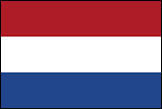
London: Unterzeichnung des Britisch-Niederländischen Vertrags. Dadurch wird Südostasien in zwei Einfluss-Sphären geteilt: Nördlich der Straße von Malakka: Großbritannien, südlich davon: Niederlande. Dadurch wird der malaiische Raum in zwei Teile geteilt, die dem heutigen Malaysia (britisch) bzw. Indonesien (niederländisch) entsprechen.
Abb.: Die Strasse von Malakka als Grenze der Einfluss-Sphären: nördlich Großbritannien, südlich Niederlande
[Bildquelle: Bartholomew, J. G. <1860 - 1920>: A literary & historical atlas of Asia. -- London, o. J.]Englischer Text des Vertrags:
"Article I The high Contrasting Parties engage to admit the Subjects of each other to trade with their respective possessions in the Eastern Archipelago, and on the Continent of India, and in Ceylon, upon the footing of the most favoured Nation, their respective Subjects conforming themselves to the local Regulations if each Settlement.
Article II
The Subjects and Vessels of one Nation shall not pay, upon importation or exportation, at the Ports of the other in the Eastern Seas. Duty at a rate beyond the double of that at which Subjects and Vessels of the Nation to which the Port belongs are charged.
The Duties paid on exports or imports at a British Port on the Continent of India, or in Ceylon, on Dutch botooms (vessels) shall be arranged so as, in no case, to be charged at more than double the amount of the Duties paid by British Botooms
In regard to any article upon which no Duty is imposed, when imported or exported by the Subjects, or on the Vessels, of the Nation to which the Port belongs, the Duty charged upon the Subjects or Vessels of the other shall be in no case, exceed six per cent.
Article III
The High Contrasting Parties engage, that no Treaty hereafter made by Either, with Native Power in the Eastern Seas, shall contain any Article tending, either expressively, or by the imposition of unequal duties, to exclude the Trade of the other Party from the Ports of such Native Power; and that if any Treaty now existing on either Part any Article to that effect has been admitted, such Article shall be abrogated upon the conclusion of the present Treaty.
It is understood that before the conclusion of the present Treaty, communication has been made by each of the Contrasting Parties to the other, of all Treaties or Engagements subsisting between each of Them, respectively, and any Native Power in the Eastern Seas; and that the like communication shall be made of such Treaties concluded by Them, respectively, hereafter.
Article IV
Their Britannick and Netherland Majesties engage to give strict Orders as well as to Their Civil and Military Authorities, as to Their Ships of War, to respect the freedom of Trade, established by Articles I, II and III; and, in no case, to impede a free communication of the Natives in the Eastern Archipelago with the Ports of the Two Governments, respectively, or of the Subjects of the Two Governments with the Ports belonging to Native Powers.
Article V
Their Britannick and Netherland Majesties, in like manner, engage to concur affectually in repressing Piracy in those Seas; They do not grant either asylum or protection to Vessels engaged in Piracy, and They will, in no case, permit the Ships or merchandise captured by such Vessels, to be introduced, deposited, or sold, in any of their Possessions.
Article VI
It is agreed that Orders shall be given by the Two Governments to Their Officers and Agents in the East, not to form any new Settlements on any of the Islands in the Eastern Seas, without previous Authority from their respective Governments in Europe.
Article VII
The Moluccas Islands, and especially Amboyna , Banda, Ternate, and their Immediate Dependencies, are expected from the operation of the I, II, III, and IV Articles, until the Netherland Government shall think fit to abandon the monopoly of Spices; but if the said Government shall, at any time previous to such abandonment of the monopoly, allow the Subjects of any Power, other than Native Asiatic Power, to carry on any Commercial Intercourse with the said islands, the Subjects of His Britannick Majesty shall be admitted to such Intercourse, upon a footing previously similar.
Article VIII
His Netherland Majesty cedes to His Britannick Majesty all his establishments on India, and renounces all privileges and exemptions enjoyed or claimed in virtue of those Establishments.
Article IX
The Factory of Fort Marlborough and all the English Possessions on the Island of Sumatra, are herby ceded to His Netherland Majesty; and His Britannick Majesty further engages that no British Settlement shall be formed on that island, nor any Treaty concluded by British Authority, with any Native Prince, Chief, or State therein.
Article X
The Town and Fort of Malacca, and its Dependencies, are herby ceded to His Britannick Majesty; and His Netherland Majesty engage, for Himself and his subjects, never to Form any Establishments on any part of the Peninsular of Malacca, or to conclude any Treaty with any Native Press, or State therein.
Article XI
His Britannick Majesty withdraws any objections which have been made to the occupation of the Island of Billiton and its Dependencies, by the Agents of the Netherland Government.
Article XII
His Netherland Majesty withdraws the objections which have been made to the occupation of the Island of Singapore, by the Subjects of His Britannick Majesty.
His Britannick Majesty, however, engages, that no British Establishment shall be made on the Carimon Isles , or on the Island of Bantam, Bintang, Lingin, or on any of the other Islands South of the Straits of Singapore, nor any Treaty concluded by British Authority with the Chiefs of those Islands
Article XIII
All the Colonies, Possessions and Establishments which are ceded by the preceding Articles shall be delivered up to the Officers of the respective Sovereigns on the first of March, 1825. The Fortifications shall remain in the state in which they shall be at the period of the notification of this Treaty in India; but no claim shall be made, on either side, for ordinance, or stores of any description, either left or removed by the ceding power, nor for any arrears of revenues, or any charge of administration whatever.
Article XIV
All the Inhabitants of the Territories hereby ceded, shall enjoy, for a period of six years from the days of the Ratification of the present Treaty, the liberty of disposing, as they please of their property, and of transporting themselves, without let or hindrance, to any country to which they may wish to remove.
Article XV
The High Contrasting Parties agree that none of the Territories or Establishments mentioned in Articles VIII, IX, X, XI and XII shall be, any time, transferred to any other Power. In case of any of the said Possessions being abandoned by one of the present Contracting Parties, the right of occupation thereof shall immediately pass to the other.
Article XVI
It is agreed that all accounts and reclamations arising out of the restorations of Java, and other Possessions to the Officers of His Netherland Majesty in the East Indies – as well as those which were the subject of a Convention made at Java on the twenty-fourth of June, 1817, between the Commissioners of the Two Nations, as all others – shall be finally and completely closed and satisfied, on the payment of the sum of one hundred thousand pounds, sterling money, to be made in London on the part of the Netherlands, before the expiration of the Year 1825.
Article XVII
The present Treaty shall be ratified, and the Ratifications exchanged at London, within Three Months from the date hereof, or sooner if possible.
In witness whereof, the respective Plenipotentiaries have signed the same, and affixed thereunto the Seals of their Arms.
Done in London, the Seventeenth day of March, in the Year of Our Lord One Thousand Eight Hundred and Twenty-Four.
(L.S.) George Canning (L.S.) Charles Watkin Williams Wynn"
[Quelle: http://en.wikipedia.org/wiki/Talk:Anglo-Dutch_Treaty_of_1824. -- Zugriffc am 2015-03-04]
1824-08
Chinesisches Geisterfest (中元節): Kampf zwischen Hokkien (福建) und Teochew (潮州) in Ban Nong Prue (บ้านหนองปรือ)
Abb.: Lage von Ban Nong Prue (บ้านหนองปรือ)
[Bildquelle: OpenStreetMap. -- Creative Commons Lizenz (Namensnennung, share alike)]
"In August 1824, during a festivity at Ban No'ng Prue [บ้านหนองปรือ] quarrels broke out between Hokkien [福建] and Taechiu [Teochew - 潮州] Chinese. A certain Chinese called Chuang, from Ban Bang Ka Čha [บ้านบางกะจะ], and a member of the Tuahia society, conspired with another Chinese named Phaw, a member of the Yihia society. They had some 7-800 Taechiu friends, who shared their grievances against the Hokkiens. The Hokkiens were protected by Phraya Suntho'nsetthi. Chuang and Phaw took Ban Bang Ka Čha and went to overpower the house of Phraya Suntho'nsetthi. Phraya Suntho'nsetthi called the Hokkien Chinese up to battle, and the governor of Čhanthaburi [จันทบุรี] ordered various officials to collect their men and fight Chuang and his Tuahias. Chuang lost the battle and fled. Many were wounded and died. Chuang and Phaw could be caught, and they implicated the deputy governor. Thereupon the governor sent his deputy, together with the two ringleaders to Bangkok. The deputy was punished by a beating and being sentences to cut grass for elephants, but Chuang and Phaw were executed." [Quelle: Terwiel, Barend Jan <1941 - >: Through travellers' eyes : an approach to early nineteenth century Thai history. -- Bangkok : Duang Kamol, 1989. -- S. 195]
1824-08

Der Brite (Schotte) Robert Hunter (gest. 1848) lässt sich als erster westlicher Kaufmann in Bangkok nieder. Er ist in Siam bis 1844.
Abb.: Robert Hunters Haus in Bangkok 1840
[Bildquelle: Neale, Frederick Arthur: Narrative of a residence at the capital of the Kingdom of Siam : with a description of the manners, customs, and laws of the modern Siamese. -- London : National Illustrated Library, 1852. -- S. 33]
"He [Robert Hunter, - 1848] did not settle in Bangkok at once, but made journeys to and from Singapore and traded with the Rajahs of Pattani [كراجأن ڤتتاني], Trengganu [ترڠڬانو] and Kelantan [كلنتن] on these journeys. He also apparently retained business interests in Singapore. Buckley, in his Anecdotal History of Old Times in Singapore, republishes Braddel’s list of European Inhabitants of Singapore in March 1827. There Robert Hunter is given as of the firm of Morgans, Hunter & Co. There is a record of another trading venture in 1833. George Windsor Earl, who wrote Voyages and Adventures in the Indian Archipelago 1832, 1833 and 1834, describes a journey to Bangkok with Robert Hunter. He says he had on board several seamen belonging to a vessel of Mr. Hunter which had lately been sold in Singapore, and Hattee, a fat good humoured little Siam- Chinese, the personal attendant of Mr. Hunter. Hunter proved a most agreeable companion. He had spent many years in the different parts of the Archipelago and therefore possessed valuable information concerning it. No one desiring to do business came to Bangkok without bringing gifts, and Hunter arrived at an opportune moment. King Phra Nang Klao [พระนั่งเกล้า
/ Rama III.] was experiencing trouble at Viengchan [ວຽງຈັນ / Vientiane], and among the gifts which Hunter brought were a thousand muskets from India, which no doubt proved very acceptable at this juncture. The King had the wood on which the the barrels were placed painted red, and these muskets are known in the country to-day as pün rang deng [ปืนร่างแดง]. But despite careful search in likely places I have not been able to find one of these muskets. The Museum has been examined without success, nor does the collection of arms at the Ministry of War contain one.[...]
By vessels trading to Siam the building was called the British factory, but to the Siamese it was always known as "Hang Huntraa." The factory was the rallying point for all foreigners visiting the country, and in all the books of the period one finds references to to the hospitality of Robert Hunter, who not only accommodated visitors, but in virtue of his position afforded them introductions to the Siamese and accompanied them to Court when the Sovereign gave audiences.
[...]At this time Portugal was the only one of the western nations which had a Consulate established here. It was opened in 1820. But she had little, if any, trade directly with Siam, and no great amount through her East India dependencies. Great Britain was represented in trade by Hunter, and there were several Mussulman merchants whose business brought to Bangkok three or four ships annually from Bombay. The native commerce of the kingdom was carried on entirely by means of junks of Chinese fashion up to 500 tons burthen. Square rigged vessels were first built in the Second Reign by the Phra Klang [พระคลัง], as Government vessels. One was named Buddha Ummarth and the other Riddhi. They were used both for trading and sending Missions to China. In the Third Reign not only were more trading vessels built, but also war ships, such as Siam Bipop, Chop Samute, Soot Sagara, Chon Chap Chor, and Phonephen Tale. The building of these was superintended by the late Regent, known in the Third Reign as Khoon Sit (Luang Siddhi Naiwen), and later by Phra Nai Wai (son of the Phra Klang). Some Siamese and Chinese merchants also built square-rigged vessels, but made the head of the vessel like a junk. Bradley [Dan Beach Bradley, 1804 - 1873] in his calendar, describing his recollections of 1835 (Third Reign), says Hunter had then about four vessels annually making voyages for him. The larger junks plied between Bangkok, Singapore, and Batavia [heute: Jakarta] ; the smaller traded to the ports on the east and west coasts of the Gulf of Siam. Junks in the China trade then, as now, made one voyage each way a year. From February to June there were 60 to 80 of these junks moored in the river in two lines. These junks were practically a great bazaar for a period of two months or more from the time of their arrival. Each junk was freighted with the goods of several parties, and the commodities brought were chiefly teas, silks, Chinese crockery and Japanese wooden and lacquer ware.
[...]
Some stories are still current regarding his business dealings. On one occasion he persuaded an official to provide him with the measurements of the floor of the Amarindr Hall [พระที่นั่งอมรินทรวินิจฉัย], and in due time a costly carpet arrived which Hunter wished to sell to the King. But not only was the price rather high but the official had evidently misled him, for the carpet was much too small; and the King refused to buy. No one else dared to buy it and finally with the King’s permission the Phra Klang was allowed to purchase it, and it long adorned the sitting room of that nobleman’s residence.
In 1843 Hunter advised the Phra Klang to have a steamer such as was then in use in Europe. The Phra Klang was in favour of making the purchase if the price was not too high. Hunter ordered the vessel which duly arrived and was moored in front of the Phra Klang’s house (until recently the residence of the late Chao Phya Bhanuwongse [เจ้าพระยาภาณุวงศ์มหาโกษาธิบดี, 1830 - 1913]). Capt Bronze brought the vessel out. She was a paddle boat and called "Express." Difficulties arose regarding the price, and the boat was not bought. It is said the King was not impressed and pretended he did not believe an iron boat could float. An experiment was accordingly made with an iron bowl belonging to a priest, and on seeing that it floated Krom Luang Midisawarind, as he afterwards became, then the head of the Chang Sang (department for making arms) examined the steamer and subsequently made a small model for the King to see. His Majesty thereupon declared that there was no need to buy the imported vessel as when such boats were needed they could be made in Bangkok.
At this time cowrie shells were universally in use as small change, and were brought by vessels coming from Surat [સુરત] and Bombay, together with other goods for the Indian merchants located at Tük Khao and Tük Deng, and there was a considerable profit attaching to their re-sale. A percentage of every shipment was presented to the King and the accumulations were kept in large Sawankaloke jars under the Chakra Vatti Hall [พระที่นั่งจักรพรรดิพิมาน] in the Palace. In the 12th year of the Third Reign the King sent three nobles to visit Singapore and the Malay States, and on their return they reported that a copper coinage was in use in Singapore, and Hunter was requested to submit several kinds, and if one was approved an order would be given. The Phra Klang had two models made. One had Muang Tai [เมืองไทย] in Siamese characters and two stars on the one side, and on the reverse a model of an elephant. The other was a design of lotus flowers. The coins did not commend themselves to the King and, when a small consignment arrived, Hunter found they were not wanted.
Not only did Hunter import, but we also find him conducting a thriving and profitable export business.
[...]
It may not be without interest to describe briefly the method of commercial intercourse between the firm and the Siamese. Goods were sold on credit, and the mode of payment was principally produce for export, the exportation of ticals being seemingly prohibited. When the sugar produce practically became a royal monopoly, dealers in sugar only being able to sell to the King or his representative, it created an awkward situation for the foreign traders, and Hunter was not slow to lay a complaint before the Governor of Prince of Wales Island [Penang], and later before the Governor General of India. The details which follow are taken from the correspondence published in the Burney Papers. James Hayes, his partner in business, first petitioned the Governor of Prince of Wales Island. After detailing the transactions of the firm in sugar, which Hayes maintained were being carried on at a loss, he proceeded. —
"In 1841 my firm in Siam had purchased up a very large quantity of teakwood timber. The exportation of Teak having been allowed hitherto, no suspicion had been entertained of a prohibition of this article, more particularly so, as the officers of the Siamese Government were aware of our buying up the said timber. If we had been informed beforehand, or while buying this timber, that its export would not be allowed, it would have prevented a very serious loss; but the Siamese did not do so until it was in the act of being shipped, and as it was principally purchased by barter, the price it commanded in Siam, when resold, left us very heavy losers. "
[...]
Abb.: Angelina Sap (?)Hunter married in 1825, and his bride was Tan Puying [ท่านผู้หญิง] Sap, whose home was close by the “Hang Huntraa” at Kadi Chin. This lady has quite an interesting ancestry, which it is believed extends back to Constance Phaulcon [Constantine Phaulkon / Konstantin Gerakis / Κωνσταντίνος Γεράκης, 1647 - 1688] of Louvo [ละโว้ = Lopburi / ลพบุรี]. I have put together the information as far as it goes in an attempt to prove the relationship of Tan Puying Sap with Chao Phya Vichayen [เจ้าพระยา วิชาเยนทร์
/ Phaulkon] of Louvo. Phaulcon was married to a Japanese lady, and they had one son. This son afterwards served Siam, and was sent as Envoy to Pondicherry [புதுச்சேரி]. He married a lady of Portuguese descent and died in 1754. There were many grandaughters of Constance Phaulcon but only one grandson, named John. He was taken into captivity at the fall of Ayuthia [อาณาจักรอยุธยา], but escaped in a few years and returned to Siam, settling in Bangkok at Sta. Cruz [โบสถ์ซางตาครู้ส]. One of the grand-daughters was taken to Mergui [ဗိက်] as a prisoner of war, and while there met Jean Chi, a Portuguese Captain in the Burmese Army, and subsequently married him at Mergui in in 1768. He was a Catholic and came from Macao [澳門]. Of this marriage there was a daughter, Philippa, who married one Ta Vian, and was alive in 1861, when a census of the people at Sancta Cruz was taken. Angelina Sap was the daughter of this marriage, and she was born in 1805, and married in 1825 to Robert Hunter. She was thus a great grand-daughter of Phaulcon. The lady is spoken of as being a beauty, extremely fair, with eyes like Queen Victoria. She was accomplished, and it is not unlikely that part of her early life was spent in the palace of Wang Lang [วังหลัง]. In Bishop Pallegoix's [Jean-Baptiste Pallegoix, 1805 - 1862] book is a woodcut of a Siamese lady, which is said to be the portrait of Angelina Sap, and which Chao Phya Bhaskarawongse has recognised. Her portrait was used as being the fairest type the Bishop could get. Before her marriage she was always spoken of as Tan Puying Sap. She dressed grandly and was considered to be the most fashionable person of her day. On great occasions her silk panung [ผ้านุ่ง] was converted into a skirt, and she wore big silk pahoms (black or pale yellow). In old age she was stout, with very little hair.Hunter was a sportsman, and fond of sailing. He had a cutter called "Friends” of about thirty tons burthen, in which excursions to the islands at the head of the Gulf were undertaken.
Of the marriage one son was born, in 1827, and was named after his father. He was sent home to be educated, and when ho returned the father built himself a building on the klong at Sancta Cruz to the north of the “factory.” It was in front of Angelina Sap’s old home. Hunter the second married in 1849 Rosa Ribeiro de Alvergarias Noi, the Catholic daughter of Phya Viset Songkram. Of this gentleman Crawfurd wrote in 1822: —“ I had an interview this afternoon with Pascal Ribeiro de Alvergarias, descendant of a Portuguese Christian of Kamboja. His acquirements were remarkable, for he not only wrote the Siamese, Kambojan, and Portuguese languages with facility, but also spoke and wrote Latin with considerable propriety.....He was married to the lineal descendent of an Englishman named Charles Lister, a merchant who settled in Kamboja in 1701. ”
He was descended from the Cambodians who settled in Samsen [สามเสน], but at the time of his daughter’s wedding was said to be living at Ban Kamen, on the site now occupied by the palace of the Prince of Kambaeng Bejra [กำแพงเพชร]. Robert the second was liked by the Siamese and in the course of time received the Siamese title of Luang Sura Sakorn, and carried on the duties which John Bush was later on to develop, and which are to-day under the control of the Harbour Department. Hunter the second had a great deal to do with Sir John Bowring [1792 - 1872] when that Minister arrived in Siam. On the arrival of the “Rattler” in the river Hunter went on board, and Sir John says: —
“As far as I can see the arrangements tor my entertainment have been confided to the care of Mr. Hunter. ” The “Rattler” after some discussion came up river and moored opposite the British factory. “ I am located, ” Sir John wrote, “ in the building called the British factory, but the building has been reconstructed and put in good order for my reception. I occupy two appartments above—a sitting room, large and airy, and a bedroom which has been newly papered, in which I sleep in a bed which is ornamented with drapery of scarlet and gold and from which garlands of flowers are suspended. Jars of fresh water are placed on my table with bouquets of roses and a Siamese servant speaking English has me in special charge. ”
At one of the plays given by the King in honour of Sir John at which Hunter was also present, His Majesty called out to Mr. Hunter suggesting that he should bring Mrs. Hunter to the palace to dance, adding “that he knew this lady could dance as well as any of the performers then playing. ” It is to be assumed that the King spoke from knowledge as we know that the lady was brought up in the Palace."
[Quelle: Moore, R. Adey: An early British merchant in Bangkok. -- In: Journal of the Siam Society. -- 11,2 (1914/15). -- S. 21 - 36]
1824-08-01

Krönung von König Rama III. Kurz darauf zieht er in die königliche Residenz und alle Prinzen und Beamten leisten den Treue-Eid (oath of allegiance).
1824-08-15
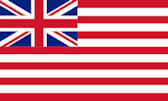
Der britische Zweimaster (Brigg) Shannon bringt neben anderen Waren 5.000 Vorderlader (Musketen) und eine große Menge Munition aus Singapur nach Siam.
Abb.: Musketen, um 1820
1824-08-15

John Crawfurd (1783 – 1868) schreibt an den Phra Klang (พระคลัง, Außenminister), dass die Briten Rangoon (ရန်ကုန်) erobert haben.
"I again beg to know how the English and Siamese can best assist each other in conducting the war against the Burmans." [Zitiert in: Mayoury Ngaosyvathn [ມະຍຸຣີ ເຫງົ້າສຼີວັດທະນາ] ; Pheuiphanh Ngaosyvathn [ເຜີຍພັນ ເຫງົ້າສຼີວັດທະນາ] <1946 - >: Paths to conflagration : fifty years of diplomacy and warfare in Laos, Thailand, and Vietnam, 1778-1828. -- Ithaca, N.Y. : Cornell Univ., 1998. -- 270 S. ; 26 cm. -- (Studies on Southeast Asia ; 24). -- ISBN 0-87727-723-0. -- S. 118]
Der Brief führt auch den britischen Waffenhändler Robert Hunter (gestorben 1848-09-07) beim Phra Klang ein.
1824-08-20 - 1829

Robert Fullerton (1733 - 1831) ist Gouverneur der britischen Honourable East India Company von Penang und ab 1826 Gouverneur of the Straits Settlements. Fullerton wird sehr beeinflusst von John Anderson (1795–1845, siehe oben), dem Anführer der Anti-Siam-Fraktion in Penang.
Abb.: Penang und die übrigen Straits Settlements
[Bildquelle: Bartholomew, J. G. <1860 - 1920>: A literary & historical atlas of Asia. -- London, o. J.]
"Robert Fullerton (born Edinburgh, Scotland 1773; died Lonondon 1831) was a Governor of Penang and also the first Governor of Straits Settlements, appointed by the Colonial Office, London. He died in 1831 in London, England. Penang 1824-1829
Robert Fullerton received his original appointment on 4 Feb 1824 and was Governor of Prince of Wales Isle from 20 Aug 1824 to 1826 after which he became the Governor of the newly incorporated Straits Settlements of Singapore (including Christmas Island and the Cocos-Keeling group), Penang (including Province Wellesley), and Malacca under the British administration in India. The Governor of the Straits Settlements was assisted by three Resident Counsellors; the Resident Counsellor of Penang, the Resident Counsellor of Malacca and the Resident Counsellor of Singapore.
Robert Fullerton became the first Governor of the Straits Settlements, based in Penang, and served in that capacity from November 27, 1826 to November 12, 1829. The departure of the last Governor is also recorded in the Gazette. The issue of 29 August 1829 carries the following notification:
"The Honorable the Governor, being about to proceed to Singapore and Malacca, NOTICE is hereby given that this station will cease to be the seat of Government from the date of his departure, and the charge of the settlement will devolve upon the Honorable Robert Ibbetson, Resident Councillor; to whom all local references will be made.""
[Quelle: http://en.wikipedia.org/wiki/Robert_Fullerton. -- Zugriff am 2013-06-24]
1824-08-28

Brief des britischen Waffenhändlers John Morgan aus Singapur. Er kündet darin folgende Waffenlieferungen an:
- 10.000 Musketen für Rama II. + 500 Musketen als Geschenk Morgans
- 150 Musketen für Prinz Chetsadabodin (พระเจ้าลูกยาเธอ กรมหมื่น เจษฎาบดินทร์, 1788 - 1851), den künftigen Rama III
- 100 Musketen für den Phra Klang (พระคลัง, Außenminister)
- 20 Artilleriewaffen für Fort Paknam (ปากน้ำ)
1824-09-10 - 1832-05-01

Somdet Phra Bawornrajchao Maha Sakdi Polsep (สมเด็จพระบวรราชเจ้ามหาศักดิพลเสพ; 1785 – 1832) ist Front Palace (Uparaj) (กรมพระราชวังบวรสถานมงคล).
"Maha Sakdi Polsep (mit Titulatur Somdet Phra Bawornrajachao Maha Sakdi Polsep, Thai: สมเด็จพระบวรราชเจ้ามหาศักดิพลเสพ; * 21. Oktober 1785 in Bangkok; † 1. Mai 1832 ebendort) war von 1824 bis zu seinem Tod Thronanwärter in Siam. Maha Sakdi Polsep wurde als Sohn von König Rama II. (postum Buddha Loetla Nabhalai, reg. 1809 bis 1824) und dessen Nebenfrau Nuiyai geboren und erhielt zunächst den Namen Arunotai. Später machte man ihn zum Kromamuen Sakdi Polsep und kommandierte ihn zusammen mit seinem Halbneffen Kromamuen Jessadabodin in den Kampf nach Birma.
König Rama II. hatte vor seinem unerwarteten Tod 1824 keinen Thronerben ernannt, deshalb musste der Thronrat und der Adel einen Nachfolger suchen. Der natürliche Thronerbe wäre Prinz Mongkut, der spätere König Rama IV. (reg. 1851 bis 1868) gewesen, doch entschied man sich für Jessadabodin (เจษฎาบดินทร์), der lange Zeit erfolgreicher Handelsminister war und als Rama III. den Thron bestieg. Er ernannte nach seiner Krönung sogleich Maha Sakdi Polsep am 21. Juli 1824 zum Thronfolger.
1825 wurde Siam in den Britisch-Birmanischen Krieg hineingezogen, was König Anouvong (ເຈົ້າອານຸວົງ) von Vientiane(ວຽງຈັນ) zu einem Aufstand veranlasste. Der König sandte daraufhin Maha Sakdi Polsep und General Bodindecha (เจ้าพระยาบดินทรเดชา, 1777 - 1849) in den Isaan (อีสาน), im Nordosten des heutigen Thailands, um den Aufstand niederzuwerfen. Anouvong musste nach Annam fliehen und seine Hauptstadt Vientiane wurde zerstört.
Maha Sakdi Polsep ließ den Tempel Wat Bowonniwet (วัดบวรนิเวศวิหาร) errichten, den heutigen Sitz der Sangharaja (พระสังฆราช). Prinz Mongkut ließ sich dort ordinieren, um den Hofintrigen zu entgehen, und wurde Abt. 1829 ordnete er die Verlegung des Buddha Chinnarat (พระพุทธชินราช) aus dem Wat Phra Sri Rattana Mahathat (วัดพระศรีรัตนมหาธาตุ) in Phitsanulok (พิษณุโลก) in den Tempel nach Bangkok an. Da sie aber heute noch in Phitsanulok steht, handelte es sich wohl um eine Kopie der Statue.
Als Maha Sakdi Polsep bereits 1832 verstarb, ernannte Rama III. keinen Nachfolger."
[Quelle: http://de.wikipedia.org/wiki/Maha_Sakdi_Polsep. -- Zugriff am 2012-03-29]
1824-09-16 - 1830-08-02

Charles X (1757 - 1836) ist König Frankreichs.
Abb.: Charles X, 1829
[Bildquelle. Wikiepdia. -- Public domain]
1824-10-25

Paris (Frankreich) Eröffnung des großen Hauses für Konfektionsmode La Belle Jardinière. Es ist der erste Konsumpalast. Bangkok wird in der zweiten Hälfte des 20. Jahrhunderts ein Habitat für Konsumpaläste sein. 1883 beschreibt Émile Zola (1840 - 1902) im 11. Band des Romanzyklus Rougon-Macquart "Au bonheur des dames" die Welt eines Pariser Modepalastes in ihren vielfältigen Aspekten.
Abb.: Inserat
Abb.: Titelblatt
ausführlich: http://www.payer.de/thailandchronik/ressourcen.htm